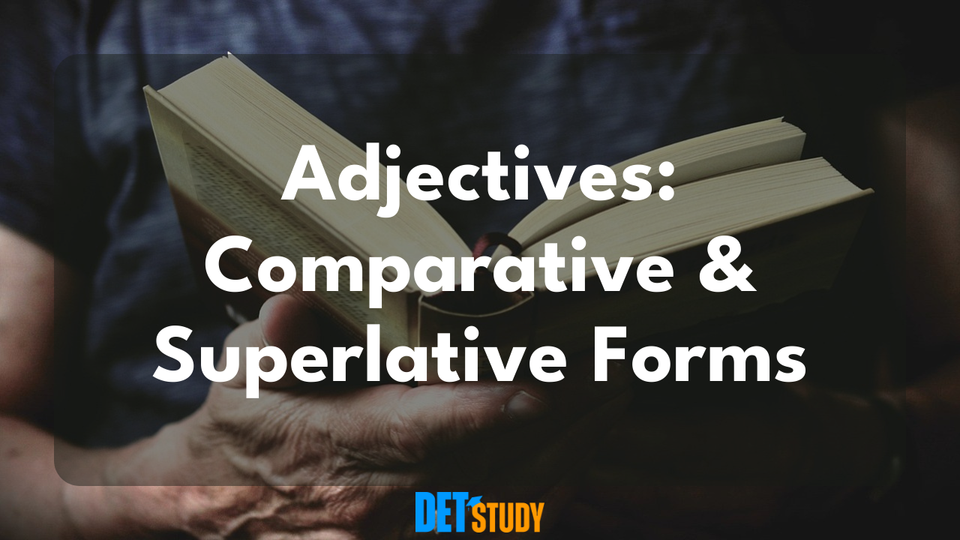比較級・最上級形容詞の完全習得:手軽に英語の語彙力を高める方法

形容詞を理解する:基本と重要性
形容詞を理解する:基本と重要性
形容詞は名詞を記述したり修飾したりして、詳細を加え、言葉をより鮮やかにします。🎨 特に比較級や最上級の形を使いこなすことで、英語でのコミュニケーション能力が大幅に向上するでしょう。
これらの形は、名詞間の性質を比較します:
Read Then Speak問題の5つのヒント:Duolingo English Test比較級の形(2つのものを比較する場合)
比較級は通常「-er」で終わるか、形容詞の前に「more」を使用します。例:
- Tall: Taller(「Jenny is taller than Mark.」)
- Happy: Happier(「She is happier today.」)
- Beautiful: More beautiful(「The garden is more beautiful in spring.」)
「-y」で終わらない2音節以上の形容詞には「more」を使用します。
最上級の形(3つ以上のものを比較する場合)
最上級は最高度を示し、通常「-est」で終わるか、形容詞の前に「most」を使用します。例:
- Fast: Fastest(「Usain Bolt is the fastest runner.」)
- Intelligent: Most intelligent(「She is the most intelligent student.」)
- Funny: Funniest(「He told the funniest joke.」)
「-y」で終わらない限り、2音節以上の形容詞には「most」を使用します。
不規則な形容詞(暗記必須)✨
一部の形容詞には、標準的な規則に従わない独自の比較級および最上級の形があります。これらの例外を認識することは、正確なコミュニケーションのために不可欠です:
- Good: Better, Best(「This is a better solution.」「This book is the best I've read.」)
- Bad: Worse, Worst(「His performance was worse.」「That was the worst experience.」)
- Far: Farther/Further, Farthest/Furthest(「She walked farther.」「This is the farthest city.」「We need further discussion.」)
- Little: Less, Least(「She has less money.」「This is the least expensive option.」)
- Much/Many: More, Most(「More people are here.」「That was the most interesting book.」)
- Old: Older/Elder, Oldest/Eldest(「My sister is older.」「He is the eldest member.」注:「Elder/eldest」はしばしば人々、特に家族を指します。)
これらの形は微妙なニュアンスの英語に不可欠なので、暗記してください。「farther」(物理的な距離)と「further」(抽象的な概念)は文脈によって使い分けられます。
比較級と最上級の形容詞の作り方:ルール
これらの形容詞を作るには、その構造が重要です。覚えておくべき主要なルールを以下に示します:👇
1. 1音節の形容詞
比較級には-erを、最上級には-estを追加します。
- Cold: Colder, Coldest(「Today is colder.」「January was the coldest month.」)
- Tall: Taller, Tallest(「She is taller.」「He is the tallest person.」)
1音節の形容詞が単一の母音に先行する単一の子音(CVCパターン)で終わる場合、-erまたは-estを追加する前に、最後の子音を二重にします。
- Big: Bigger, Biggest(「This apple is bigger.」「That is the biggest tree.」)
- Hot: Hotter, Hottest(「The soup is hotter.」「July is the hottest month.」)
2. 「-y」で終わる形容詞
-yで終わる2音節の形容詞の場合、-yを-iに変えて-erまたは-estを追加します。
- Happy: Happier, Happiest(「She felt happier.」「That was the happiest day.」)
- Easy: Easier, Easiest(「This test is easier.」「That was the easiest question.」)
3. 2音節以上の形容詞(「-y」で終わらないもの)
比較級には「more」を、最上級には「most」を使用します。
- Beautiful: More beautiful, Most beautiful(「This painting is more beautiful.」「That is the most beautiful flower.」)
- Difficult: More difficult, Most difficult(「This puzzle is more difficult.」「This was the most difficult decision.」)
「narrow」や「clever」のような一部の2音節形容詞は、-er/-estまたはmore/mostのどちらも使用できます。例えば、Narrow: Narrower/More narrow, Narrowest/Most narrow。
Duolingo English Testで本物の単語と偽の単語を見分ける方法:成功のための最高のヒント4. 「-e」で終わる形容詞
比較級には単に-rを、最上級には-stを追加します。
- Large: Larger, Largest(「Her house is larger.」「This is the largest cake.」)
- Simple: Simpler, Simplest(「Instructions need to be simpler.」「She provided the simplest explanation.」)

比較級と最上級の形容詞を文章で使うためのヒント ✍️
明確で正確な文章のために、以下のガイドラインに従ってください:
-
基本を理解する: - 比較級は2つの項目に使う:「Tom is taller than Jerry.」 - 最上級は3つ以上に使う:「Alice is the tallest in the class.」
-
規則形の復習: - 1音節:-er/-estを追加(Tall: Taller, Tallest)。 - -yで終わる場合:yをiに変えて、-er/-estを追加(Happy: Happier, Happiest)。
-
「More」と「Most」: - ほとんどの2音節以上の形容詞の場合、「more」(比較級)と「most」(最上級)を使用(Beautiful: More beautiful, Most beautiful)。
-
冗長性を避ける: - 二重比較級や二重最上級(例:「more taller」や「most tallest」)は絶対に使用しないでください。これらは誤りです。🚫
-
不規則形を暗記する: - 不規則な形(Good: Better, Best; Bad: Worse, Worst)は暗記する必要があります。
-
文脈と明確さ: - 比較対象が明確であることを確認してください。比較する項目の数と文の論理的な意味に基づいて、比較級または最上級を選択してください。
-
正しい比較: - 2つの項目には比較級を使用し、最上級は使用しません。「Jan is taller than Chris」と言い、「Jan is the tallest of the two」とは言いません。
これらのヒントを適用することで、より正確で鮮やかな比較が可能になり、あなたの文章力が向上するでしょう。✨
DET Studyは、形容詞や副詞を含む文法を強化するための15,000以上の練習問題を提供しています。Duolingo English Testに自信と正確さを持って備え、目標スコアを達成しましょう。🚀
🎯 もっと練習が必要ですか?専門家によるリソース、15,000以上の練習問題、AIパワードフィードバックについては、DETStudy.comをチェックしてください。

